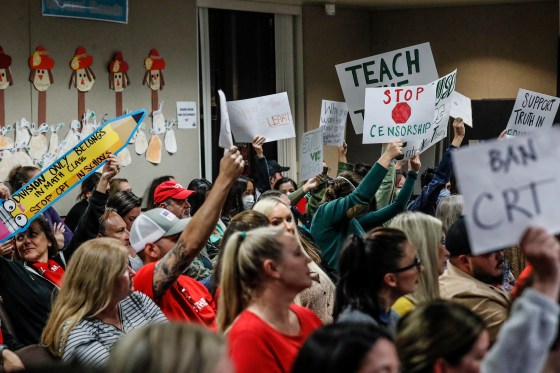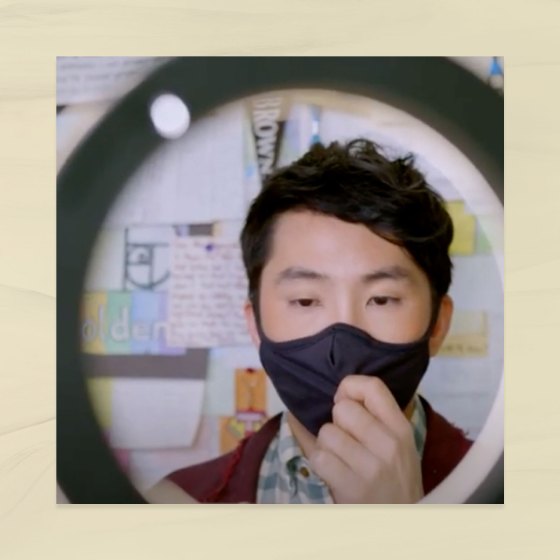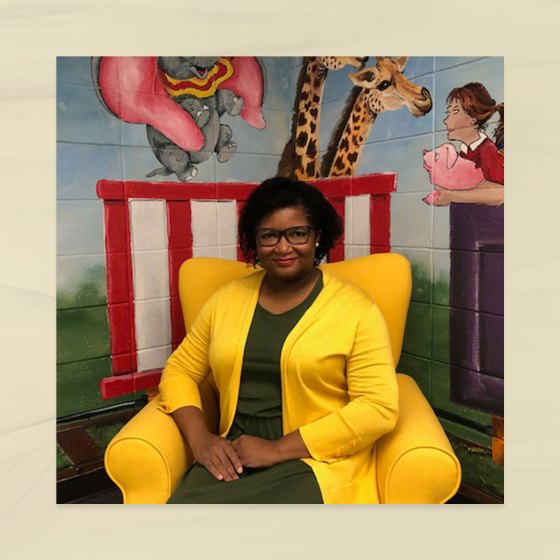NEW ORLEANS—Before the 2020-21 school year, Christa Talbott, a 20-year veteran of New Orleans schools, had never considered leaving the profession she loved this early.
But then came a dispiriting spring trying to stay connected to her students while COVID-19’s first wave ravaged her hometown. George Floyd’s murder that May left her reeling, exhausted and eager for racial reckoning on her home turf. Talbott, who is Black, began to push for change at a school that, despite its reputation for progressive politics, bore the last name of a Confederate official and dedicated proponent of school segregation, Robert Mills Lusher.
[time-brightcove not-tgx=”true”]
In the summer of 2020, Talbott and her colleagues asked for a meeting with the charter school’s leaders to discuss racial justice at Lusher, one of the city’s most coveted for families and teachers alike; they also created an antiracism group for teachers. It did not go over well. By the end of 2020, the 44-year-old was agonizing over whether the school year might be her last teaching there.
“I was tired of being quiet,” she says. “I was tired of sitting back so that white people could feel comfortable.”
Lusher, like America, has long had a teacher diversity problem: Slightly more than 20% of public school teachers—who include those at charter schools— in the U.S. identify as people of color, compared with more than half of students. Only 7% of teachers identify as Black. At Lusher, in 2020, 13% of teachers were Black compared with 22% of the students.
The research has been clear for years that many of our schools struggle less with recruiting diverse educators than retaining them: between 1988 and 2018, the number of teachers of color hired by the country’s schools increased at a faster rate than the number of white teachers, yet those diverse educators also left their positions much more quickly, on average.
Now, as Talbott’s story underscores, the problem could be poised to get worse, with Black teachers in particular feeling increased strain.
Into a burning house
Black teachers were more than twice as likely as other teachers in the winter of 2021 to say they planned to leave their jobs at the end of the 2020-21 school year, according to a report released by the RAND Corporation. And a slightly higher percentage of nonwhite teachers than white ones—45% vs. 42%—said that they were considering leaving their position last school year, researchers at the University of Arkansas’ College of Education & Health Professions found. (The gap was 30% vs. 22%, when teachers were asked if they were considering leaving because of reasons related to COVID-19.)
Despite all the recent and increasingly dire warnings of a teacher shortage in some parts of the country, we have too often failed to clarify who is most at risk from the departures: Black and Latino educators and the students of color who rely on them. Students of color perform better academically, and are more likely to stay in school, when they are exposed to teachers of their race or ethnicity. White students benefit too.
Meanwhile, many districts and schools continue to believe they can hire their way out of the teacher diversity problem—if they acknowledge it’s a problem at all—and fail to take on the hard work of transforming school culture.
Read more: What It’s Like to be a Teacher During the Pandemic
“A lot of school and district leaders take the approach, ‘We don’t care how messy or untidy or oppressive our house is—just come in anyway,’” says Sharif El-Mekki, CEO of the Center for Black Educator Development, whose organization last fall co-released with the teacher leadership and advocacy organization Teach Plus a report that lays out steps school leaders should take to retain more Black educators.
“They have not spent a second thinking about what kind of environment they are recruiting people to,” says El-Mekki, who invokes Martin Luther King Jr.’s worry, expressed shortly before his death, that he had integrated Black Americans “into a burning house.” “That could stand for teachers of color entering racially hostile school environments today,” El-Mekki says.
Starting several decades ago, several powerhouse groups and individuals invested in recruiting a more diverse teacher workforce, says Richard Ingersoll, a professor of education and policy at the University of Pennsylvania Graduate School of Education and an expert on teacher demographics. In the 1980s, the Ford Foundation partnered with other organizations to recruit and prepare more teachers of color. About a decade ago, former Secretary of Education Arne Duncan helped lead a campaign to recruit 80,000 Black male teachers. And more recently the Kellogg Foundation partnered with several historically Black colleges and universities to boost the numbers of Black male educators.

Partly because of these and related efforts, the number of teachers from underrepresented racial and ethnic groups more than doubled over the last 30 years—from about 327,000 in the late 1980s to 810,000 in the 2017-18 school year. Yet research by Ingersoll and others has shown that teachers of color disproportionately serve in some of the most challenging schools, including those with high poverty rates and lower academic performance overall. And they leave at higher rates largely because of poor working conditions—including a lack of input in key decisions affecting their classrooms—not because of dissatisfaction with teaching more broadly.
“Recruitment is great,” says Ingersoll. “But if you don’t keep them, it’s like putting water in a bucket with holes in the bottom.” Federal and state data on teacher departures lag by a year or more, meaning we won’t have a conclusive picture of the pandemic’s impact on teacher diversity for years to come. Yet early data suggests that the pandemic is aggravating the leaky bucket problem.
The RAND study was based on surveys completed in early 2021—nearly one year into the pandemic—by more than 1,000 teachers across the country. Teachers of all racial groups reported high rates of frequent job-related stress (ongoing stress for teachers was far higher than that of the general population—78% compared with 40%).
Racial stress fatigue
For all the attention paid to teacher stress and shortages during the pandemic—perceived and real—too few people are talking about the special strains on teachers of color, says El-Mekki, including pushback against the teaching of racism in America. “So many are speaking of COVID-related stress, but we should strongly consider the ramifications of COVID-related stress on top of racial stress fatigue for teachers of color,” he says.
According to the RAND study, nearly half of Black teachers reported in the winter of 2021 that they were likely to leave their jobs at the end of the school year, compared with 23% of teachers overall. “That is concerning from a workforce diversity perspective,” says Elizabeth Steiner, the co-author of the report. “It’s crucial that school and district leaders address it.”
Prior to the pandemic, Talbott had spent a dozen mostly satisfied years teaching at Lusher. After starting as a substitute in 2007, she was hired as an elementary teacher in 2009, drawn by the school’s racial diversity and stellar record in academics and the arts. Lusher enrolls students in kindergarten through 12th grade across two buildings.
Sometimes, Talbott says, she was the first Black teacher her students had had at Lusher, even after she began teaching sixth-grade social studies in 2013; it meant a lot to her to provide students with that self-recognition and affirmation. She started the Black Student Union at the middle school and formed enduring friendships with several colleagues and Lusher families. One of Talbott’s daughters graduated from Lusher in 2021; the other still attends the high school.
Read more: Inside the Fight Over What Kids Learn About America’s History
Talbott experienced microaggressions at times. When teachers expressed concerns nearly a decade ago about a new textbook they’d been told to use, Talbott says an administrator told her, “I just feel like you like being difficult and contentious.” (Among other things, Talbott says the book contained grammatical errors and introduced instructional ideas that teachers did not think supported students’ needs.) Teaching during a pandemic was exhausting and frustrating, particularly during the stretches when Talbott had to do it remotely.
“I’m a teacher who thrives on connection,” she says. “The camera didn’t allow me to make the connections like I’m used to. That did something to my teaching spirit.”
Yet she never contemplated leaving the classroom this early in her career until the summer of 2020. Not long after the murder of George Floyd by a white Minneapolis police officer, Talbott and colleagues began pushing for a meeting with administrators to discuss the need for more dialogue about race at Lusher, where the share of white students has inched up in recent years, to nearly 60%. White students account for less than 10% of the city’s public school population overall, and they are concentrated at a handful of selective admissions schools like Lusher.
<strong>“I think my voice was heard at Lusher—until it was something they didn’t want to hear.”</strong>The teachers wanted to discuss the need for more anti-racist professional development at Lusher and the possibility of increasing diversity among Lusher’s leadership, including on the board of directors, whose seven members include two people of color, according to school administrators. They also wanted school officials to send a clear message to the community that Lusher supported Black Lives Matter.

They encountered mostly silence. Officials told us “they were not there to talk but only to listen,” according to Talbott. “They sat there stone-faced. It wasn’t a conversation—it was more us trying to encourage a conversation.” Over the next several weeks, the teachers tried to follow up but say they were stonewalled.
“They didn’t think we deserved an explanation,” says Jake Gleghorn, 33, who is Asian American and worked alongside Talbott. “They didn’t think we deserved a conversation. They didn’t think we knew anything they didn’t know.”
Talbott and Gleghorn say they believe some administrators were sympathetic to their concerns but ultimately took direction from the school’s long-time CEO, Kathy Riedlinger. (Riedlinger did not reply to a request for comment on Talbott and Gleghorn’s statement.)
Not long after the meeting, Talbott, Gleghorn and other colleagues created an anti-racist working group aimed at helping the school’s teachers become more knowledgeable on subjects of race and equity. Administrators called it secretive, according to Talbott, and told the teachers not to communicate about the working group using Lusher email.
“I think my voice was heard at Lusher—until it was something they didn’t want to hear,” Talbott says.
At the same time, many in the school community were pushing for change, including abandonment of the school name. Robert Mills Lusher had been a tax collector for the Confederacy and had resigned as state superintendent of schools in Louisiana rather than oversee a system that would not remain 100% segregated. (In the fall of 2021, Lusher’s board agreed to change the name, although a new one has not yet been selected.)
As the school year continued, the situation grew increasingly tense. Throughout the fall and early winter, Talbott thought more and more about resigning, even though she did not have another job lined up. “Ultimately it boiled down to me being a Black woman who had a voice and things to say that could make us stronger, and that not being valued and appreciated,” she says.
Talbott was not the only teacher of color questioning their future at the school. After agitating for change, Gleghorn found himself removed from leadership positions on two key school committees, focused on learning and diversity. “I was told they didn’t trust me,” he says, “which I’ve since interpreted as them not thinking I was loyal.”
“Because I was speaking my mind—and not white—they didn’t know how to work with me in a way that made them feel comfortable,” Gleghorn adds. “Had I been a white teacher, I think that there would have been more direct communication.”
A principal weighs in
Several of Talbott’s and Gleghorn’s concerns were corroborated in a grievance letter to the board sent by former Lusher High principal Steve Corbett, which was obtained by the The Times-Picayune/New Orleans Advocate.
The letter, written in December, 2020, said Riedlinger told administrators they were “not to engage in any dialogue” when teachers, including Talbott and Gleghorn, brought forward their concerns in the wake of Floyd’s death. It also says that Riedlinger at one point instructed administrators to stop speaking with the Anti-Defamation League; told Corbett to cancel a staff book club meeting to discuss White Fragility, about white people’s discomfort discussing race; and expressed concern that Lusher had provided teachers with a resource library of antiracist materials.
A Lusher spokeswoman did not address specific statements regarding Riedlinger but detailed several steps she said the school has taken toward racial equity over the last year and a half. “Corbett’s allegations were fully investigated by an independent firm and found not to merit any action by the school,” a Lusher spokeswoman said in a written statement.
Corbett has since left Lusher and now serves as CEO of New Orleans’ Audubon Schools.
Gleghorn and Talbott, too, are gone.
Read more: Meet the Educators Who Saved a Pandemic School Year
Up until the 2020-21 school year, Gleghorn says he had been in the pipeline for an administrative position at Lusher. “The events of the summer and fall of 2020 really cleared up for me that I didn’t want to work for these people,” he says. In the spring of 2021, Gleghorn accepted a job at the New Orleans Career Center, a nonprofit that provides high school students and adults access to career and technical training.
In April, Talbott announced at a community meeting that she would leave at the end of the school year. She made the specifics public—particularly the fact that she had no new job lined up—because she didn’t want school leaders to dismiss the departure by implying she left for something “bigger” or “better.”
<strong>“I was tired of being quiet. I was tired of sitting back so that white people could feel comfortable.”</strong>“Real change would be open and honest conversations with all of the stakeholders in our school,” Talbott said at the meeting, reading from a prepared statement. “Real change would be immediate feedback to our students that have the courage to share their experiences. Real change would be me feeling that my voice, as a Black woman, is important.”
In a written statement, a Lusher spokeswoman, Cheron Brylski, described Talbott and Gleghorn as “quality and valued teachers” and said both had expressed a desire to leave for other opportunities before the pandemic. (Talbott denied this, as did Gleghorn. “There was no plan prior to the pandemic, prior to George Floyd,” she said. “I had talked to no one about leaving Lusher, period.”) Gleghorn and Talbott had numerous leadership opportunities, the statement said, but it did not address Gleghorn’s concern that he was removed with little explanation from leading the learning and diversity committees.
Brylski denied that Lusher leaders obstructed teachers’ efforts at open conversation of race at the school in the months after George Floyd’s murder. “Our administration listened with respect and consideration, and no follow-up conversations were stonewalled,” she said, portraying the teachers as demanding “immediate action” while Lusher leadership adhered to a slower, “well-established and proven process.”
<strong>“If I’m not going to be the one who … centers conversations on George Floyd or Stop Asian Hate, no one else is going to do it.”</strong>As a result of that process, administrators sent a school-wide communication in July 2020, which read, in part: “We affirm that Black lives matter (sic).To that end, we have defined an initial set of target concerns and action steps…We will continue to refine these as we hear and learn more.”

Takeru Nagayoshi, the 2020 Massachusetts Teacher of the Year, says it’s not surprising that teachers of color are feeling especially strained these days. They have long faced an “invisible tax” that for many has steepened over the last two years, says Nagayoshi, who’s known as TK. “When you work or navigate predominantly white spaces, you feel the need to unpack race and racism,” he says. “If I’m not going to be the one who brings up DEI (Diversity, Equity and Inclusion) or center conversations on George Floyd or Stop Asian Hate, no one else is going to do it.”
Nagayoshi, 30, decided in August to leave his job teaching Advanced Placement English in the city of New Bedford for a job at an education technology company. He continues to love many parts of the teaching profession but cited burnout stemming from different factors: increased work hours and responsibilities; coping with decreased morale and a traumatized community; low pay; and a rigid schedule that made it difficult to find sufficient time for exercise or personal relationships.
“The balance of what was acceptable wasn’t there for me anymore,” Nagayoshi says.
Finding a better way forward
Schools may be struggling more than ever to retain teachers of color, but in some places, recruitment of diverse candidates has gone up during the pandemic. Mississippi, Massachusetts, and New Jersey are among states that, fearful of teacher shortages and facing hiring challenges due to the pandemic, temporarily removed or changed some barriers to entering the field—such as extending emergency licenses or adjusting test score thresholds—that often disproportionately hurt Black candidates, who are more likely to face barriers such as less access to college prep curriculum at their high schools.
Read more: How Schools Are Struggling With a Substitute Teacher Shortage
A year and a half ago, officials in Mississippi temporarily waived many of the licensure exam requirements for new teachers, as well as test score requirements for students entering teacher preparation programs. The changes enabled Mari Williams, who is Black, to enter a teacher-preparation program for the first time. She has worked in Mississippi for years, first as a tutor and then as an assistant teacher. Yet her ACT score fell one point short of the minimum required to train for a teacher job. The waiver reignited her dream of running her own classroom.
“One of the things that convinced me to go back is that we have such a low number of African American educators across the board,” she says. “This is something I can do to bring diversity to the classroom.”
Preliminary data show that the waivers, which ended at the end of 2021, have significantly boosted the diversity of teacher candidates in Mississippi. Between 2018 and 2020, the number of people of color entering educator preparation programs jumped by more than 400%. (The growth in the number of white candidates was about 44%.)
<strong>“This is something I can do to bring diversity to the classroom.”</strong>“We were already looking at a huge teacher shortage and we did not need to compound that crisis more with COVID,” says Debra Burson, the director of educator preparation at the Mississippi Department of Education. “We opened the gate rather than closed the gate.”

Yet without a plan to support the new teachers coming in, teacher diversity is unlikely to improve significantly in the long term. “We talk about cultural competence, and many Black educators are trying to navigate their colleagues’ and supervisors’ cultural incompetence on top of everything else,” says El-Mekki.
White educators and school leaders, as well as school-district and state policy-makers must do more to support teachers of color, according to the report released in the fall of 2021. They “are not expecting perfection, but they are expecting a commitment and plans to do better—and that it’s not just on them,” El-Mekki says.
The report advises putting in place curriculum rooted in students’ cultures and life experiences, and ensuring that Black teachers have access to affinity groups and mentorship. Schools have long been held accountable for all manner of data—everything from student test scores to suspension rates and number of hot school lunches served. They must now also be held publicly accountable for recruitment and retention of teachers of color, the report concludes. That includes school districts’ establishing, and publishing, clear goals when it comes to teacher diversity, and releasing school-climate and teacher-exit surveys, with results broken down by race.
“Very few districts have goals as it relates to teacher diversity,” says El-Mekki. “You can’t move forward if you don’t know where you want to go.”
In July, Lusher families sent the school’s board a letter—now signed by more than 250 parents—pushing for the exact things that El-Mekki encourages. “We are dismayed with the administration and board’s response to student and faculty calls to confront racism within our school community,” it said in part.
Lusher, through its spokeswoman, has repeatedly insisted on the school’s commitment to diversity, equity, and staff well-being. Fewer than 9% of Lusher’s academic staff has left since the start of the pandemic, Brylski said in her statement. And the departures include just two of 33 African American educators. More than half of new hires are people of color, as are two out of three principals. Lusher’s recent efforts, according to the statement, include the adoption of a K-8 antibias curriculum, development of a “micro-aggression reporting system”and a partnership with a Louisiana State University professor to shore up the school’s approach to diversity and wellness.
When it comes to the recent teacher departures—including Talbott’s and Gleghorn’s—the school says it “encourages all staff to pursue career advancement.”
Both Gleghorn and Talbott are happy in their new jobs but say it wasn’t career advancement that precipitated their decision to leave.
After she gave notice, Talbott began overhauling her résumé, which hadn’t been updated in 20 years, and she met with a job coach. Early in the summer of 2021, she started a job with a company working to build a new social studies curriculum for public schools and districts. “My hope is to center the voices of the indigenous, of women, of Black people,” Talbott says. “Normally, when you are looking at history, the voices that are centered are those of landowning white men.”
Talbott has no regrets about the job move. “It’s a selfless profession, but I had to be selfish,” she says. “I didn’t want to be in a job where I dreaded getting up every day and going to work.”
Yet she cried on the first day of the 2021-22 school year last August while watching students across New Orleans returning to school. She missed the kids. Her departure had never been about them. It had been about following her mother’s lifelong advice: Go where you feel valued.
This story was produced by The Hechinger Report, a nonprofit, independent news organization focused on inequality and innovation in education. Learn more at hechingerreport.org.



0 Comments